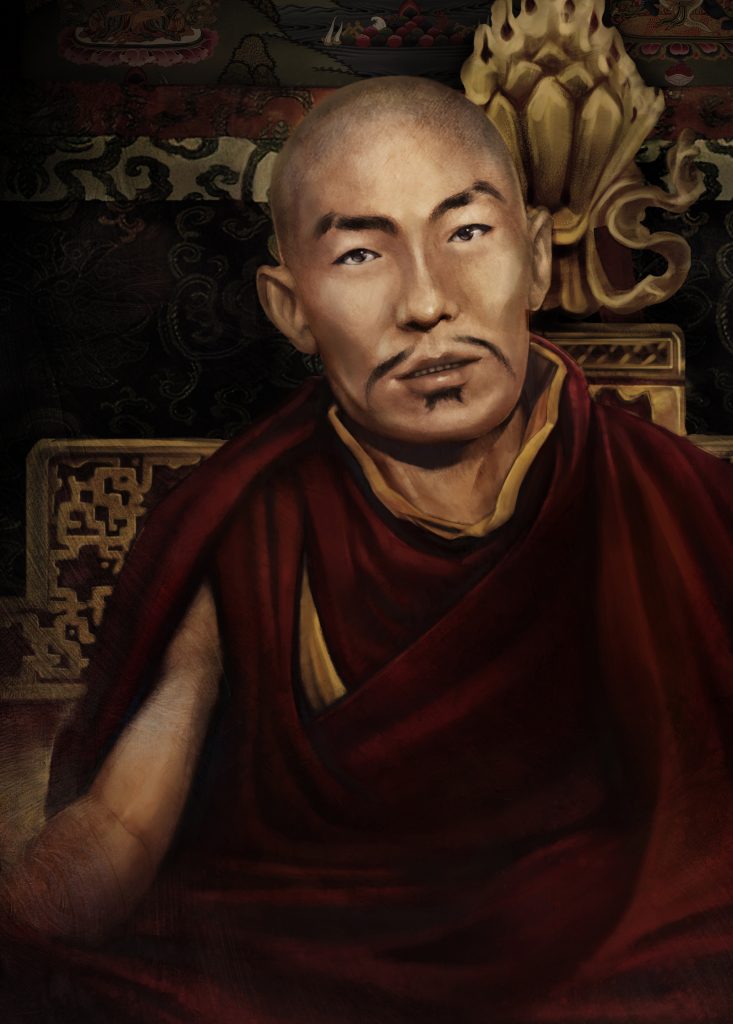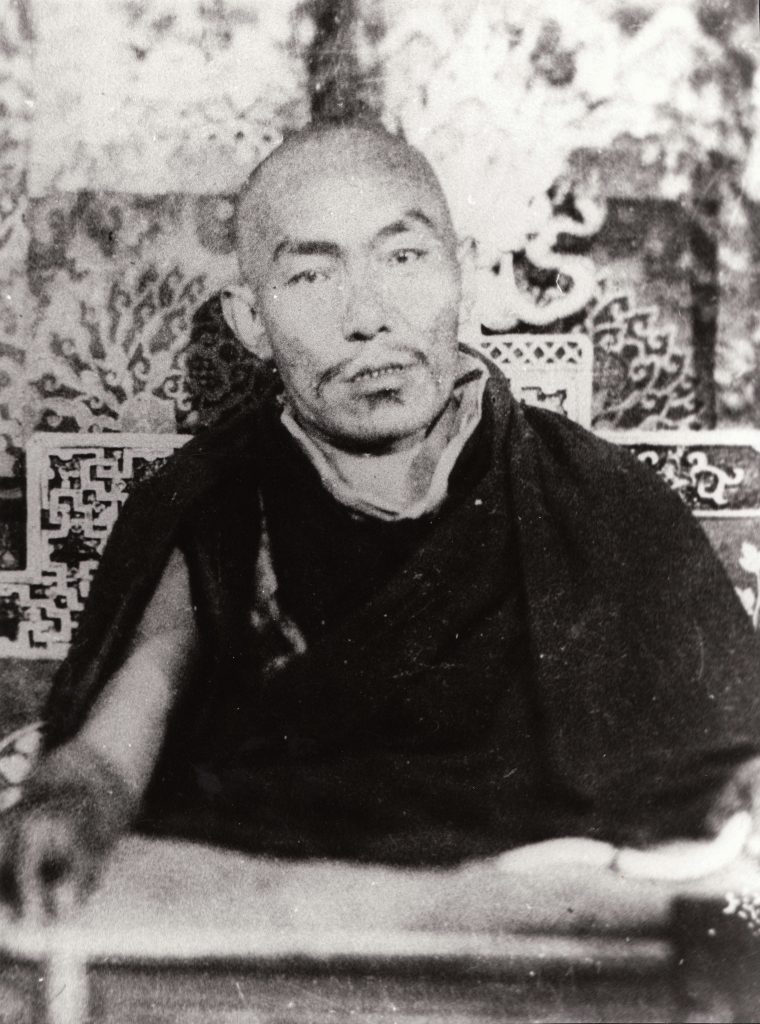Previous Lives
Dharma Pioneer of Phari
Kentrul Thubten Lamsang
 Throughout history, many holy beings have appeared to lift sentient beings out of suffering. Some appeared during times of calm and peace; others appeared during periods of upheaval and change. One such lama who manifested during times of instability in order to provide refuge for sentient beings was Kentrul Rinpoche Thubten Lamsang who discharged his bodhisattva duties during an age that saw political and social upheaval, and changing attitudes.
Throughout history, many holy beings have appeared to lift sentient beings out of suffering. Some appeared during times of calm and peace; others appeared during periods of upheaval and change. One such lama who manifested during times of instability in order to provide refuge for sentient beings was Kentrul Rinpoche Thubten Lamsang who discharged his bodhisattva duties during an age that saw political and social upheaval, and changing attitudes.
Kentrul Rinpoche was originally from Thangkya Monastery near Lhasa, before he enrolled in the famous Gaden Shartse Monastery. There, he was recognised as the incarnation of the monastery’s 72nd abbot Gedun Nyedrak, an identification that came from none other than Kyabje Trijang Rinpoche, Junior Tutor to His Holiness the 14th Dalai Lama.
Under Trijang Rinpoche’s tutelage, the young Kentrul Rinpoche excelled in his studies. He was still very young when he took his final monastic examination in front of His Holiness the 13th Dalai Lama and his tutors. Passing with honours, he was awarded the Geshe Lharampa degree, the highest academic accolade awarded by the Gelug school. Kentrul Rinpoche then enrolled in Gyutö Tantric College to pursue his tantric studies; a mere year later, he was elected as the monastery’s disciplinarian, one of three most senior positions that can be held in any Gelugpa institution.
Kentrul Rinpoche’s time in Lhasa however, would soon come to an end. At the time, there was a pressing need for someone to revive the Dharma in places where it was beginning to dissipate. With his wealth of knowledge, erudite training and mastery of the teachings, Kentrul Rinpoche was the perfect candidate for this mammoth task. And so, Trijang Rinpoche sent his esteemed disciple to some of Tibet’s most remote areas.
Kentrul Rinpoche spent a great many years in areas like Phari on the Tibet-India border, where he focused on restoring dilapidated monasteries, and reigniting the teachings and practice. He worked tirelessly to improve the condition of local monasteries and built large Buddha statues, including life-sized statues of Yamantaka, Heruka, Hevajra, as well as the past, present and future Buddhas, and a 12-foot statue of Lama Tsongkhapa with his two disciples. He also built a three-storey statue of Maitreya Buddha.
Kentrul Rinpoche was also known for performing extensive pujas for people of the area. Having observed that there was little interaction between the lay and ordained communities, he focused on strengthening their connection. He went out of his way to relieve the sufferings of the lay people in the area, and often gave monetary assistance to the poor, paid their bills, gave them food and paid off the loans of people in desperate situations.

As a result, the local people’s faith was restored and they once again began making offerings to the monasteries. The lay people also observed that Kentrul Rinpoche was highly skilled in handling both secular and religious affairs, and began to seek his advice. Businessmen from all over the Himalayan region came to seek his blessings, and requested him to perform pujas and divinations. The lay people felt that unlike many other lamas, Kentrul Rinpoche truly understood them, how they lived and what they needed. Coupled with his ability to discern between right and wrong, Kentrul Rinpoche’s judgement became highly valued – whenever particularly complex or difficult cases reached the secular courts, Kentrul Rinpoche would be approached for his ruling and mediation on legal disputes which could not be otherwise resolved.
Ultimately however, Kentrul Rinpoche is famed to this day for the unbreakable bond and faith he had in his guru Trijang Rinpoche. He is also remembered for his close Dharma friendship with His Holiness Kyabje Zong Rinpoche, another of Tibet’s most revered lamas, and they were often regarded to be as close as brothers.
But none was closer to Kentrul Rinpoche’s heart than his beloved guru, Trijang Rinpoche. Their teacher-disciple relationship has been described with a common Tibetan saying – like “a piece of flesh from the heart”. Trijang Rinpoche even had an affectionate name for Kentrul Rinpoche, often calling him “Thubten-la”. It is this relationship that influenced the most defining moments of Kentrul Rinpoche’s life.
Upon accomplishing what he had set out to do in Phari, Kentrul Rinpoche requested to return to Lhasa. However, Trijang Rinpoche knew the impact he would have on the people of Phari and instructed him to remain there. Kentrul Rinpoche readily agreed, his unwavering guru devotion overriding his personal goals. This continued even when civil unrest reached Tibet in 1959. It is said that Kentrul Rinpoche foresaw what the future held; with his clairvoyance, he knew what was happening in other parts of Tibet and due to his influence and position, he knew that the authorities would soon remove, capture, and even jail and torture him.
And because he had not received permission from Trijang Rinpoche to leave his post, in order to keep the peace between the people and nations, Kentrul Rinpoche Thubten Lamsang went quietly into a retreat in Phari and entered clear light. He passed away at the peak of his health, at 63 years of age. There was no cause for his death – no illness or any trauma to his body. It was a decision that would set the stage for the preservation and proliferation of Dharma outside of Tibet in the coming decades.
Kentrul Rinpoche will always be remembered as the lama who remained devoted to his teacher until his final moments, and for his exceptional relationship with the lay people he stewarded. He manifested during a time of great change and flux, when the people most needed guidance and hope, and that is exactly what he gave to them. His is a legacy that is timeless and beyond compare.
